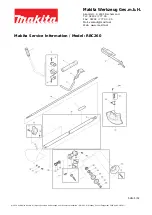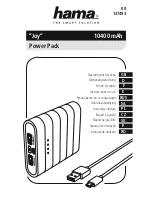
KT5500 5-
1
/
2
” T
ong
& CLInCHER® B
aCKup
S
ECTIon
C
onTEnTS
3.29
T
ECHnICaL
M
anuaL
M
aInTEnanCE
D
epressurizAtion
p
roceDure
f
or
s
torAge
:
1) Rotate the tong to the “open throat” position.
2) Exercise each hydraulic cylinder several times - open the tong and backup doors (if equipped), retract and extend the
remote backing pin ramp (if equipped), retract and extend the float cylinders. Leave all cylinders except for the door
cylinders in their fully retracted position. The general idea is to have as little of the chrome cylinder rods exposed as
possible.
3) De-energize the power unit.
4) Repeatedly actuate the tong motor control valve lever IN BOTH DIRECTIONS to dissipate any residual pressure in the
valve and motor.
5) Remove the hydraulic SUPPLY line from the equipment.
6) Repeatedly actuate the remaining control valve levers IN BOTH DIRECTIONS to dissipate any residual pressure in the
remainder of the hydraulic control system.
7) Connect a low-pressure air supply line (10 PSI or less) to the hydraulic supply line, and force a small amount of the
remaining hydraulic fluid from the valve assembly - this will allow for thermal expansion of the hydraulic fluid if the
equipment is stored or transported in high ambient temperatures. Failure to do this may result in damaged or destroyed
seals in the equipment.
8) Disconnect the hydraulic RETURN line from the equipment.
9) Disconnect remaining hoses such as case drains, or lines connected to the turns counter.
13.
Energize power unit. Rotate tong for one minute, stop, and reverse the direction of rotation for another minute, ending with
the opening of the rotary gear facing the gear train.
14.
De-energize the power unit, and perform a third generous lubrication of the gear train, including the gear housing.
15.
Energize power unit, and rotate the tong for a final time, one minute in one direction, stop, and reverse the direction of
rotation for another minute, this time ending with the rotary gear in the “open throat” position.
16.
Extend all hydraulic cylinders, and inspect cylinder rods for signs of mechanical damage, flaking, or rust. Farr recom-
mends that damaged cylinders be replaced prior to storage.
17.
If you are using a frame-mounted tool, the tong must be lowered onto the backup in order to remove the risk of sudden
and catastrophic movement when pressure is removed from the float cylinders. Cover the top of the backup with protec-
tive cloth to protect the paint on the backup. Place two wooden beams across the top of the tong, ensuring that the beams
have a minimum size of 4” x 4” x the width of the tong. Cover the tops of the wooden beams with more protective cloth to
prevent paint damage to the tong. When lowering the tong onto the beams, ensure that the beams come into flat contact
with the bottom of the tong, away from bearing caps, brake bands, or other protrusions on the bottom of the tong. Ensure
that the tong hanger chains are loose, but not dangling into contact with the hangers or top plate of the tong.
23.
Allow the anti-corrosive coating ample time to dry - refer to manufacturer data sheets for drying times at room tempera-
ture.
24.
Wrap entire assembly in 100 gauge (1 mil) corrosion-inhibiting wrap, at least 3 layers thick. Attempt to ensure that the tool
is well-sealed within the wrapping, including the bottom.
18.
If any hydraulic fittings or hoses are leaking they must be repaired or replaced before proceeding.
19.
Wipe all excess grease from outside of equipment. Replace the access door panel. Use a solvent-based cleaner on
rags to wipe all external surfaces to remove residual grease or hydraulic fluid. Once the outside surfaces have been de-
greased, wipe all external surfaces with clean water to remove residual solvent.
20.
Farr recommends that chain slings be removed and stored separately. Rigid slings and other rigid suspension devices
may remain in place.
21.
Apply grease or heavy oil to all exposed cylinder rods.
22.
Farr recommends that an anti-corrosive agent such as Tectyl
®
506 be applied to all external surfaces EXCEPT cylinder
rods (including chain slings). Refer to manufacturer data sheets for proper application and safety information.
DO NOT ALLOW ANTI-CORROSIVE AGENTS TO CONTACT CYLINDER RODS. CYLINDER ROD
DAMAGE WILL OCCUR.
Summary of Contents for 80-0420-16
Page 2: ......
Page 4: ...This page intentionally left blank ...
Page 6: ...This page intentionally left blank ...
Page 10: ...This page intentionally left blank ...
Page 34: ...This page intentionally left blank ...
Page 120: ...This page intentionally left blank ...
Page 128: ...This page intentionally left blank ...
















































